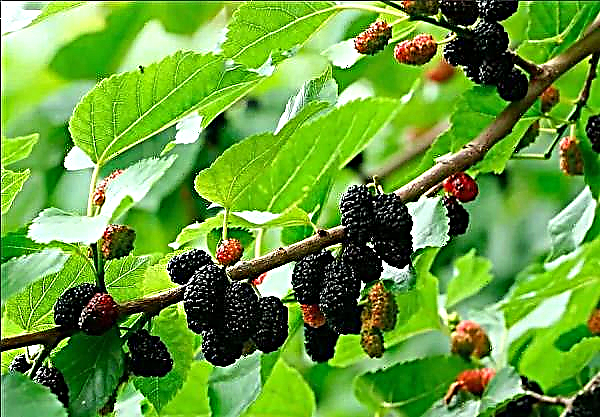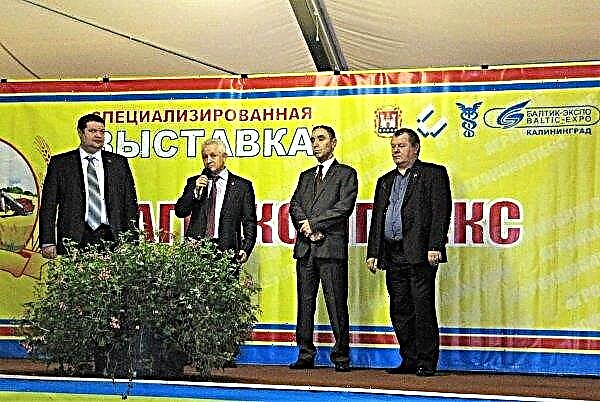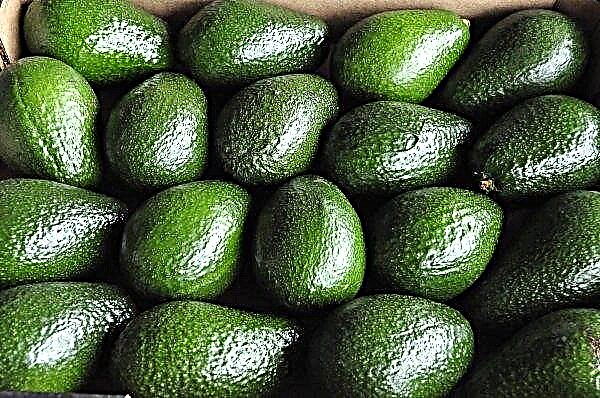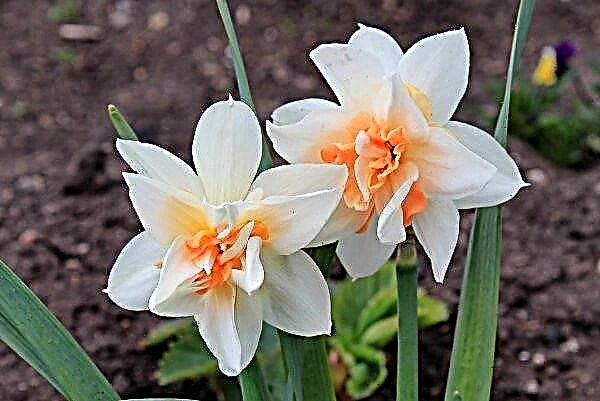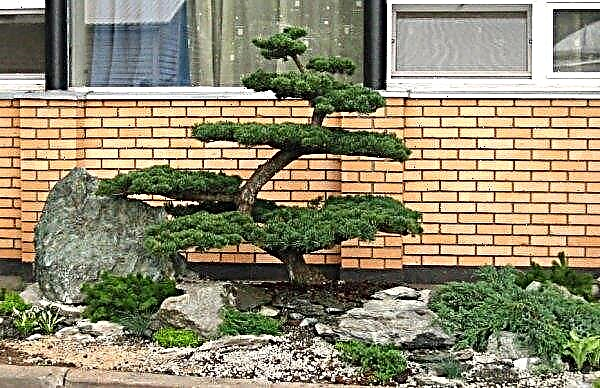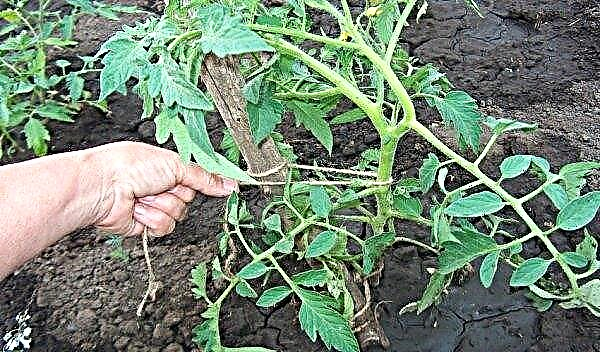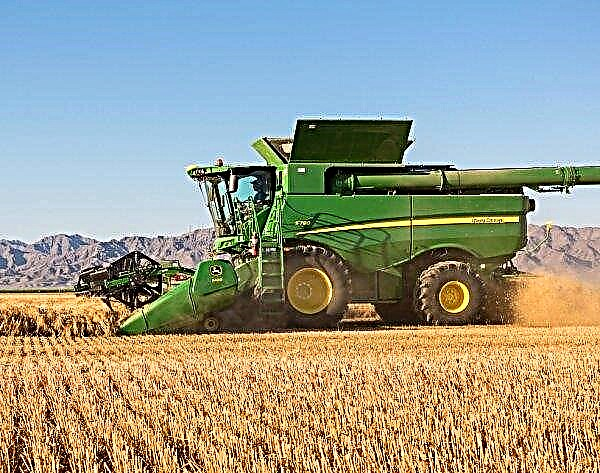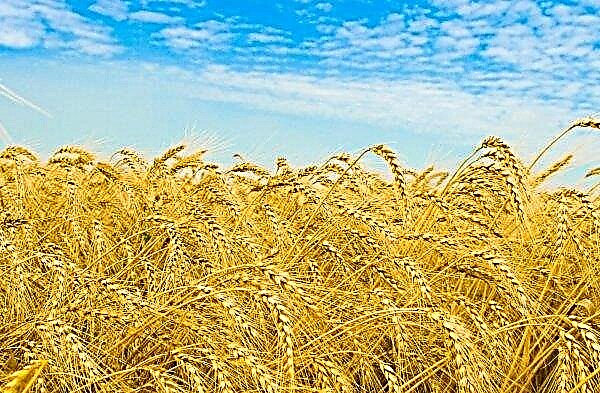A feature of mid-season Kornabel F1 tomatoes lies in their unusual elongated shape with a narrowed lower part. At first glance, the fruits of the hybrid are difficult to distinguish from red bell pepper, and its juicy sweet-sour fleshy flesh has an unforgettable taste. In addition, the bushes bear fruit well and do not require additional human intervention. Learn about the advantages and disadvantages of Cornabel tomatoes, as well as the intricacies of caring for them later in the article.
History of Variety Breeding
The authorship of pepper-shaped tomatoes belongs to the breeders of the famous French company Vilmorin. In 2003, their efforts were crowned with success. The new variety really pleasantly surprised consumers not only with its appearance, but also with its taste characteristics. Vegetable growers appreciated the undemanding nature of the hybrid during cultivation, high productivity and the same fruit size.
The variety can be cultivated both in the greenhouse and on the open ground. It is poorly developed in regions with a cold climate, since it is oriented to the southern latitudes. In a temperate climate zone, this species of nightshade is best grown in cover structures.
Characterization and description of the variety
Kornabel develops on an indeterminate type. Its powerful stems reach 170 cm in height, and fruiting begins 120 days after sowing.
The plant has a well-developed root system with deep processes, grows branched bushes. The branches are not densely leafy, which contributes to uniform lighting.Did you know? Fearing poisoning caused by tomatoes, Europeans for a long time grew them for decorative purposes, and America’s history even included a case when ill-wishers tried to poison George Washington with a tomato dish.
The hybrid practically does not get sick, because it is characterized by genetic resistance to all common diseases of solanaceous crops.
Productivity
Depending on the climatic features of a particular region, fruit ripening occurs in July-August. Subject to the agrotechnical rules for growing crops, even from a small garden, you can harvest a good crop.
During fruiting, 5–7 tomatoes weighing from 150 to 220 g are formed on each flower brush. In general, about 15–17 kg of vegetables ripen on one bush.
Video: Togmat cultivar Kornabel F1
Description of the fetus
Cornabel F1 is distinguished by high taste and marketability of the crop. These are medium red fruits of elongated shape, which is almost identical to bell pepper. In length they reach 15 cm. Some specimens can weigh about 0.5 kg.
Tomato peel is thin, but elastic, and the pulp is juicy and slightly granular. There are no voids inside, since the seed chambers are very small with a minimum number of grains.
The fruit tastes sweet, with tangible notes of acidity. A large accumulation of solids was found in the flesh of the hybrid; by its content, the variety topped the rating of solanaceous crops.Important! When hothouse cultivation of tomatoes, it is necessary to take into account the degree of heating of the structure. If the inside temperature is below + 10 ° С, then it is recommended to treat all internal surfaces with an aqueous solution of laundry soap and Fitosporin.
Such tomatoes can easily transport and can be stored fresh for a long time. They are recommended for use in the preparation of salads, various dishes, juice, as well as for consumption in fresh and canned forms.
Advantages and disadvantages of the variety
- Among the merits of the variety, gardeners note the following:
- excellent taste and marketability of fruits;
- high productivity;
- the ability to form an ovary even in adverse weather conditions;
- disease resistance;
- the ability to transport the crop over long distances and keep it fresh for a long time;
- universality of the use of ripe tomatoes;
- prolonged fruiting.
- Among the shortcomings of vegetable growers are called:
- the need for the timely formation of bushes, as well as their tying to supports, due to the unlimited growth of stems;
- the high cost of planting material;
- inability to grow a hybrid from harvested seeds.
Optimal timing for growing
It is better to plan tomato seedlings for seedlings at the end of February - early March, depending on the climatic characteristics of the cultivation region. It is important that until the moment of transplantation to a permanent place, the stems are strengthened and strong roots grow. To do this, they will need at least 60 days.
Keep in mind that indeterminate hybrids need to be sown a few weeks earlier, compared to other varieties. However, overgrowing seedlings should not be allowed. Seedlings must be found in an open area before flowering begins. Otherwise, they will not take root, or will be stunted.
With the greenhouse cultivation of Kornabel, the sowing time depends on the material and features of the shelter structures. For example, in heated structures, tomato planting should occur in late April. But in greenhouses that are equipped with an internal additional covering layer of polyethylene, this is best done in the first decade of May. The same terms should be observed, and when you plan to plant tomatoes in a polycarbonate greenhouse. If the room does not provide additional shelter and heating installations, it is better to start planting seedlings after the 20th of May.
No less important is the condition of the soil, as well as the temperature of the air in the greenhouse. Ideally, the substrate should heat up to stable + 15 ° С, and air - up to + 20 ° С.
Regardless of the place and method of growing the hybrid, in the autumn you need to prepare the soil, enriching it with the main nutrient components (nitrogen, phosphorus, potassium).
Did you know? In the Ukrainian cities of Kamenka-Dneprovskaya and Tsyurupinsk monuments were erected.
Growing Features
The maximum return on the hybrid can be achieved only with strict adherence to agricultural regulations.
Growing seedlings
Tomatoes are best sown in peat containers or tablets, as this material is environmentally friendly and nutritious. In addition, there is no need for a picking of grown seedlings. Defect in such products can be considered deoxidation at regular overflows of plants, as well as the appearance of mold.
Before sowing the grain, it is advisable to withstand 4-6 hours in warm water with the addition of any growth stimulant ("Emistim", "Kornevin", "EcoSil").
After that, fill the prepared containers with fertile moist soil, plant the seeds on top, covering them with a layer of earth and compacting it with your palm. In each pot, it is advisable to sow 2 grains. Then cover the containers with plastic wrap and put in a warm place for several days.
When shoots appear, it is important to provide seedlings with proper care and optimal temperature conditions. Plants will be comfortable at a temperature of + 20 ... + 22 ° C.
In the early stages, it is advisable to water the hybrid once a week, and with the appearance on the stems of 2 or more full leaf plates, the number of waterings should be doubled. In this case, use only room temperature-stabilized water for 24 hours. It is important to monitor the state of the earthen coma in the pots, preventing its waterlogging and drying out - otherwise fungal and bacterial infections, as well as excessive acid in the taste of the surviving fruits, are inevitable.
Two-week seedlings require additional application of nitrogen-containing and phosphorus-potassium substances. The nutrient solution is prepared in a ratio of 3: 1: 1. In this phase of the development of shoots, you should not overdo it with organic matter, since in room or greenhouse conditions, the stems can stretch and fall.
Important! Tomato fruits are practically not tied if the stalks poorly absorb nitrogen. This occurs, as a rule, with a lack of phosphorus.
Particular attention should be paid to lighting throughout the growing period of tomato seedlings. With insufficient daylight, the seedlings require additional illumination with fluorescent lamps (they must work in the morning and evening for 8 hours).
When the sprouts get stronger and reach a 30-cm height, they can be transplanted into the open ground. It is better to plan a transplant in the evening, or to do it in cloudy weather. A week before this, seedlings begin to harden, exposing containers to fresh air.

Preparation of land for planting seedlings
Open beds, as well as greenhouses, require preliminary preparation. To do this, in the autumn, remove from the selected area all the remains of the precursor plants, after rain or heavy watering, spread fertilizers and dig deep into the soil. Then level it with a rake and slightly compact.
For each square meter, you will need to add up to 4 kg of compost or humus, as well as about 80 g of superphosphate, 1 kg of wood ash and at least 2 kg of peat.
Please note that fresh manure is strictly contraindicated in vegetable beds, as it attracts pathogenic microbes and pests. Caution will not be superfluous when using peat, because this component contributes to the oxidation of the soil. To exclude these undesirable consequences, experienced gardeners advise adding a little dolomite flour to the nutrient mixture (for alkalization), and generously pour manure with a 5% solution of copper sulfate before use.
To clear the soil of harmful insects, digging is best done immediately before frost. And with the onset of spring, the soil is loosened and smoothed with a rake.Tomato seedlings are transplanted after they have received stable heat when the air warms up to + 15 ... + 19 ° С, and the earth - up to + 14 ° С. Do not forget to immediately clear the bed of weeds that appear and loosen the soil with a chopper.

Seedling Planting Technology
In the prepared area, you need to make holes up to 14-15 cm deep and water them abundantly. Between neighboring plants, it is desirable to leave space within a half meter with aisles of 60-100 cm.
Given the tendency of Kornabel F1 to unlimited growth, it is better to plant a hybrid in rows. This will facilitate care, and will also contribute to better ventilation of the basal part of the stems. As a result, on each square meter of the site you should get 2 bushes. Larger quantities are not allowed.
Peat pots with seedlings are placed in the prepared moist depressions and sprinkled with fresh soil. Over time, the product material will dissolve, giving its nutritional components to tomato roots.
If the sowing of the seeds was carried out in tablets, they will need to be carefully removed from the containers. Make sure that the soil completely covers the root neck.Important! An acidic environment is strictly contraindicated in tomatoes. In autumn, in such areas, to correct soil acidity, dolomite flour, lime, cement dust or old plaster (150 to 300 g / m²) should be added.
Basic crop care rules
Kornabel for its full development requires the same conditions as other tomato varieties. If the culture is provided with an optimal regime of moisture and heat, nutritious soil and good ventilation, the first ripe fruits will appear 60–75 days after transplanting the seedlings to a permanent place.
Watering
Constant dampness of the soil is fraught for a tomato plantation with the development of Fusarium and other fungal diseases. And dry land will inevitably lead to inhibition of growth and, possibly, even the death of the plant.
Avoid these unwanted effects by moderate watering; optimally - 2-3 times a week. At the initial stages of development, about half a liter of water should be poured under each bush, and as the growth grows, the portion of water should increase to 1 liter.
It is better to do all the moisturizing procedures in the garden and in the greenhouse in the morning. This will help to avoid intensive evaporation of soil moisture, as well as burns on the foliage of the crop.
For irrigation of tomatoes, only water that has stood for a day with a temperature not lower than room temperature is suitable.
Did you know? Although more recently (on a historical scale) tomatoes were considered poisonous, today they belong to the primacy in the ranking of world vegetable growing. About 60 million tons of these fruits are harvested on the planet per year.
Top dressing
The quality and nutrition of the soil is one of the factors affecting the intensity of fruiting of garden crops. Kornabel is able to form an ovary even with adverse external factors, but a rich soil content for the hybrid is necessary.
The first dressing can be done a week after the seedlings are transplanted to a permanent place, when they adapt to new conditions. Reapplication of fertilizers is relevant 14 days after. Pay attention to the growth rate of stems and foliage color. If the branches develop poorly, and the central shoot is weak and fragile, another feeding will not be superfluous. She should be planned 2 weeks after the second.
Pay attention to the growth rate of stems and foliage color. If the branches develop poorly, and the central shoot is weak and fragile, another feeding will not be superfluous. She should be planned 2 weeks after the second.
In the initial phases of development, tomatoes respond well to a solution of chicken droppings or mullein, prepared in the appropriate proportions 1:15 or 1: 8. Keep in mind that an excess of nitrogen in the soil will provoke an active build-up of biomass, thereby damping the fruitful qualities of the hybrid.
Pasynkovka and formation of a bush
For tall tomato varieties, pinching the stepsons is mandatory. Otherwise, instead of a neat bush with beautiful clusters of pepper-shaped fruits, you will grow an immense giant with lush branches and a meager harvest. In addition, filamentous shoots that are not capable of bearing fruit are not excluded.
Experienced vegetable growers are advised to remove the lower leaves on the stems and pinch the top of the central sprout. This is done to stimulate lateral branching. Also, periodically, pinch stepsons in the lateral deciduous sinuses.
The stepsoning procedure provides for constant control over the process of branching and bush growth. Unwanted biomass, which takes too many nutrients for its development, is plucked after it reaches 2-3 cm in length. To prevent new shoots from appearing in the same place, experts advise making a cut not at the stem itself, but at the level of 1 cm.
Hybrid varieties of tomatoes are best formed according to a two-stem scheme. On each of the left sprouts, after the appearance of flower brushes, you need to pinch off the tops at the level of 3-4 inflorescences.
Important! In the southern regions, where the cultivation of indeterminate tomatoes in the open ground is practiced, pinching of the upper shoot of the central trunks should be carried out in the early stages of bush formation. And in conditions of protracted damp weather, the removal of all unformed flower brushes is required.
Interminant varieties require binding support. This is due to the risks of damage to the stems under the weight of the ripening fruit, as well as the possible infection with fungal infections due to poor ventilation of the root zone of the bushes.
Many gardeners set tall poles of rhinestones on a tomato bed after transplanting seedlings. This solution allows you to immediately fix the desired branches in the correct position. As garters, soft fabric tows or garden clips are preferred. It is not recommended for such purposes to use a rigid metal wire and a thin fishing line.
Other vegetable growers advise tying bushes to horizontal supports - this method is very well suited for greenhouse structures.You can also fix tomato branches on a special trellis, but this option is only relevant in cases where there is a need to develop lateral sprouts.
Soil weeding
A high yield of tomatoes is possible only in fertile soft soil, therefore the fight against weeds is one of the most important requirements in the care of a vegetable crop. Competing with unnecessary vegetation, it loses the necessary mineral and organic substances. In addition, weed-covered areas attract pests, and a poorly ventilated area becomes a source of development of fungi and pathogens. Therefore, weed tomato plantation should be regularly.
For the first time this is done with a chopper 2 days after transplanting seedlings in open ground. You need to act as carefully as possible so as not to damage the weak roots.Important! The best predecessors for tomatoes are: cabbage, beans, peas, onions, garlic, cucumbers.
Subsequent weeding is relevant to the extent of the appearance of weeds on the site. In addition, after each irrigation, you need to loosen the earth, thereby preventing the appearance of a hardened crust. The loose earth passes oxygen well, due to which tomato roots develop better.
14 days after planting, seedlings need to be spud.
Diseases and pests of the variety
Cornabel is resistant to most common diseases of solanaceous crops.
But with gross violations of the rules of agricultural technology, the hybrid can become infected:
- late blight (occurs in the absence of ventilation of the root zone of the bushes, in conditions of increased dampness and heat);
- gray rot (occurs due to soil fungi, which are activated at a temperature of + 20 ° C and humidity above 68%);
- black leg (the cause of infection is increased moisture);
- mosaic of tomatoes (the aphid is the carrier of the infection, more often the disease occurs during the dive period);
- bacterial tomato cancer.
It will be useful for you to find out more about tomato diseases and how to deal with them:
Among the potent drugs, agrochemists note: “Skor”, “Khom”, “Maxim”, “Fundazol”, “Isabion”, “Prestige”, “Barrier”.
With rare weeds or their complete absence on the bed, the following are expected:
- scoops;
- spider mites;
- whiteflies;
- aphid;
- caterpillars
- gall nematodes;
- Colorado beetles (these pests can appear even on a well-groomed plantation).

In advanced situations, the only salvation of the infected area may be roasting or scalding with boiling water the upper layer of soil, as well as deep plowing of the lower layers. Then it will not be superfluous to water the earth with a weak solution of potassium permanganate.
Important! Tomatoes are sensitive to shade, as well as the accumulation of cold air, rain and melt water. These nuances should be considered when choosing a place for landing.
Harvesting and storage rules
A feature of the high-yielding Kornabel variety is also in long-term fruiting. 2 months after transplanting seedlings to a permanent place, the first tomatoes will ripen. To the extent of the appearance of ripe specimens, they are removed from the stems.
The hybrid can be transported over long distances, as well as stored fresh for about 3-4 weeks (the cellar or refrigerator is best suited). Also, these fruits are perfect for making juices, various sauces, home canning and salads. Such processing will significantly extend the shelf life of the crop.
Tomatoes of the French selection Cornabel F1 deserve attention due to a number of their advantages. This variety is ideal for small greenhouses (in cold regions) and gardens. The variety is more productive when grown outdoors.

